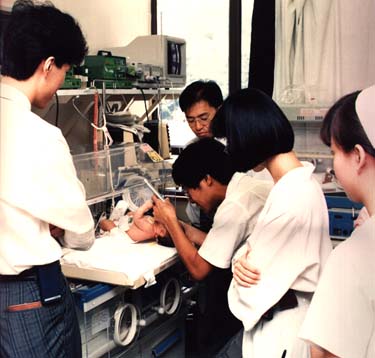

Since the opening of the Prince of Wales Hospital in 1984, the Department of Paediatrics has always played an important role both as a teaching and a health care institution. It has three major areas of responsibility. One is to provide first rate service to the public. The other is the teaching of paediatrics to the medical students of the Chinese University of Hong Kong. The third is to offer post-graduate training in Paediatrics.
Underlying its strength as a health care and teaching institution, the Department of Paediatrics has achieved a level of excellence that is unmatched in Hong Kong in two subspecialties.
Neonatal Intensive Care Unit The Unit is the centre of tertiary referral. It is by far the largest and the most busy unit in Hong Kong. It handles an average of 8000 deliveries each year.
Haematology/Oncology Unit Since 1984, the Department of Paediatrics has always been the centre of referral of patients with cancer and blood diseases. At present, the Department of Paediatrics treats more than 50% of the paediatric cancer cases an performs the majority of bone marrow transplant operation for children in Hong Kong. We are now a member of the International Bone Marrow Transplant Registry. With such a rapid expansion of service and an increase in patient workload, the need for better facilities has become clear not only to the medical profession but also to the public as well. As a result, the idea of a children cancer centre was born. The opening of the Lady Pao Cildren's Cancer Centre in November 1994 represents a major step forward in the history of medicine in Hong Kong. The centre is to provide the best of medical care for children suffering from cancer and blood diseases. It has a total of 40 beds, of which 5 are designated for bone marrow transplant patients and 10 beds in Day Care Centre. The centre also has a playroom, a classroom for the patients and a parent overnight room and a rest area for their parents.
In research, the Department made medical history by successfully treating a patient homozygous for protein C deficiency. In co-operation with the Tokyo Medical and Dental University the mutant protein C gene was characterised. Both of his parents were heterozygous for the deficiency. The one derived from the mother represents a deletion of 5 nucleotides (mutant I). The other derived from the father represents a point mutation from an amino substitution (mutant II). Since the abnormal genes are named traditionally after the place where they are discovered, they are called Protein C Hong Kong 1 and Protein C Hong Kong 2, thus putting Hong Kong on the map. Ever mindful of the fact that Haematology/Oncology as a subspecialty is very laboratory-oriented, and thanks to the Hong Kong Paediatric Bone Marrow Transplant Fund, the Children's Cancer Fund and the Medical Faculty of the Chinese University of Hong Kong, a molecular biology laboratory was established in the Department in 1993. Increasingly sophisticated laboratory tests in both diagnosis and treatment of blood diseases and cancer are being established without which clinical haematology/oncology cannot be practised to the highest level of excellence. The research programmes that are currently being conducted include the following:
With the most up-to-date and state-of-the-art technology and equipment and , above all, the dedication of the medical, nursing and laboratory staff, the Lady Pao Children's Cancer Centre will undoubtedly be an important centre for clinical and basic research as well as for the diagnosis and treatment of cancer and blood diseases in children in Hong Kong.
Other major contributions made by the Department include the nutritional study of Hong Kong children and re-write of growth charts based on extensive research. These growth charts have replaced the previous ones and are now widely used in Hong Kong.
The Department of Paediatrics at the Prince of Wales Hospital is one of the busiest paediatric units in Hong Kong. This is not surprising in view of the large number of young couples who have settled in the new territories. It has an annual admission rate of over 8,000 and it is on a rising trend.